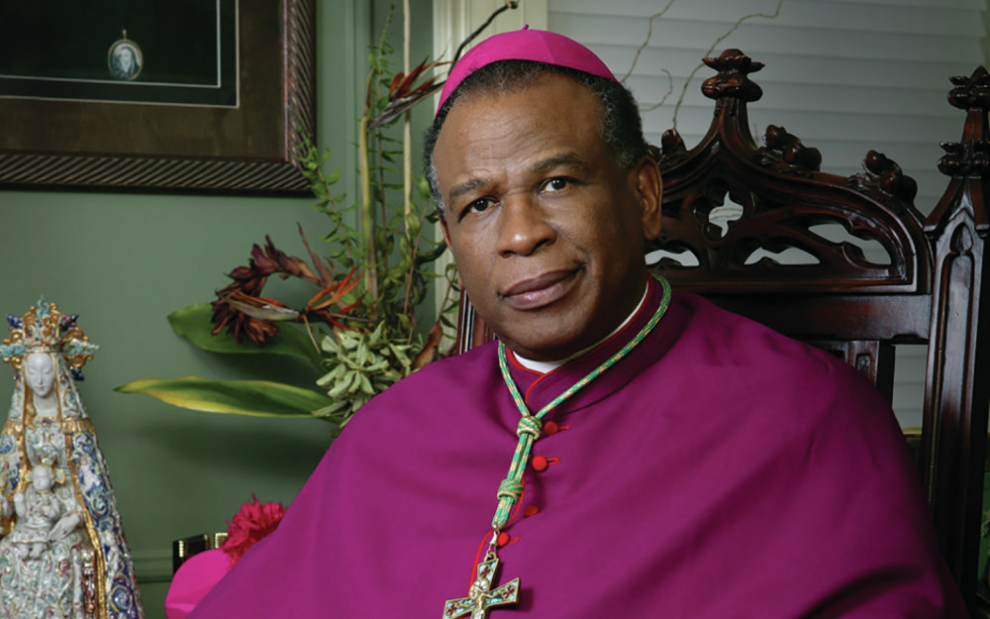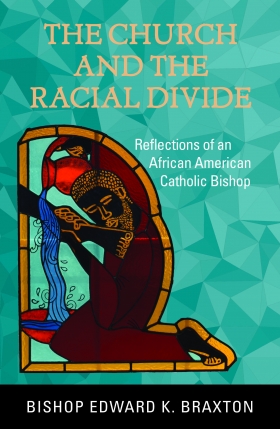Bishop Edward K. Braxton, bishop emeritus of Belleville, Illinois, says that today’s society uses the word racism too freely. It is used to refer to anything from inadvertent racial biases to the physical lynching of human beings, and its widespread and frequent use in the media, by religious communities, and by individuals means that it has lost preciseness and power.
Instead, Braxton says, it’s more accurate to talk about the racial divide: a broader expression of oppression that encompasses everything from overt racism to racial biases and prejudices.
Talking about the racial divide allows us to be more precise when talking about anti-oppression and racial justice. “Those who harbor racial bias in their hearts, even unconsciously, may be guilty of the moral fault of prejudice,” he says. “But they may not, in every case, be guilty of the grave sin and evil of racism.”
In his new book, The Church and the Racial Divide: Reflections of an African American Catholic Bishop (Orbis Books), Braxton wrestles with this racial divide within the U.S. Catholic Church. He urges readers to recognize their own complicity in the racial divide without judging others and while remaining open to the Holy Spirit’s call to justice.
“The goal is to attain a greater understanding and mutual respect of one another,” says Braxton. “This can only come about by a deep interior conversion of hearts made possible by an openness to the Holy Spirit. It is, in truth, a high and distant goal.”
You have written and spoken extensively on what you call the “racial divide in the United States.” What do you mean by this expression?
Today, many individuals, groups, and the media commonly use the words racism and racists to cover a wide range of behavior: from expressions of racial bias to inappropriate comments to the enslavement of free human beings.
The church was on the wrong side of history from the very beginning of the racial divide.
This widespread use has become even more common with the emergence of a new consciousness caused by the horrific murder of George Floyd. I am certainly aware of the presence of racism in American society and in the Catholic Church. However, for me it is imprecise to speak of racism and racists as frequently and as broadly as it is done today. If even the smallest expression of racial bias or prejudice is an example of racism, then almost everyone might be called a racist.
Instead, I speak of the racial divide as a broader phenomenon of which racism is the most egregious example.
Can you elaborate on this distinction?
The racial divide began in 1619 when the first free men and women of color were brought in chains from West Africa to the United States to provide “free” labor and maintain the economy by working as “beasts of burden” on sugar, tobacco, and cotton plantations.
This divide has continued throughout American history, including through the Civil War era and up to the Supreme Court’s Dred Scott decision, which argued, in effect, that African people had no standing before the court, since they were not human beings but “property.” (Sadly, this opinion was written by Chief Justice Roger B. Taney, a Roman Catholic who “owned” enslaved human beings and whose faith in Jesus Christ did not open his eyes to the dignity and worth of every human being.)
This unjust divide continued with Jim Crow laws and the frequent lynching of African American men, women, and children between 1880 and 1940, a slaughter of the innocent often celebrated by white mobs as “entertainment.” It continued up to the cruel murder of the Rev. Dr. Martin Luther King Jr. Today, it continues as we reflect on the murder of Floyd and the deaths of so many others at the hands of representatives of law enforcement.
The racial divide is apparent to this day in many people’s systemic and systematic treatment of people of color as inferior and undeserving in this country. This leaves Black Americans at a disadvantage as they seek a good education, meaningful employment, decent housing, health care, and every other form of social advancement and benefits. All these instances of the racial divide are examples of racism.
Do you think most Americans, including Catholics, are “racists”?
It is very difficult to harbor truly racist attitudes and beliefs in your heart without realizing it. Most Americans and most Catholics are probably not racist, at least in the way I understand the word. However, it is possible for someone to live with an unconscious or a barely conscious awareness that they harbor biases, prejudices, and stereotypes that influence their attitudes toward people of different races, nationalities, religion, sexual orientations, and the like. People may even acknowledge that these attitudes are wrong and constitute a genuine moral fault.
This moral fault becomes racism—a moral evil and a grave sin—when individuals and groups allow these biases to lead them to think they are objectively superior to all members of the group in question. This denial of universal human dignity and worth can easily lead to the affirmation of white privilege and white supremacy. This is expressed in hostility and open hatred, including a willingness to harm, oppress, and even enslave people of a different race. This racism is manifest with insults and pejorative language. It deprives people of their natural and civil rights, such as voting, living wherever they wish to live, and the opportunity to attain a good education, obtain good health care, and pursue a career in the field of their choice.
All the wishing and wanting and hoping for change doesn’t make it so.
Advertisement
Those who live each day oblivious to the biases, prejudices, and racial stereotypes that influence them may never speak or act in a crudely racist way. They may never admit to the fact that they are the beneficiaries of a systemic racism that impacts all dimensions of American society, including the church.
It is not by chance that the majority of Catholic parishes are more or less racially segregated to this day. This is due in part to the fact that the church was on the wrong side of history from the very beginning of the racial divide.
Today, a growing number of the Christian faithful and laypeople, religious, deacons, priests, and bishops are deeply aware of the racial crisis in this country, and they are sincere in their desire to bridge the racial divide, even as they acknowledge that they do not know what they should or can do. They believe they have a responsibility to work with seriousness to remove prejudice and even racism from their hearts and from the Christian community.
As members of the body of Christ, all Catholics are called to learn, love, and live their faith. When they consume the body and blood of Christ, they must truly believe that they become what they eat. They become Christ, who needs their eyes to continue to see, their hands to continue to serve, and their hearts to continue to love.
Do you think the Catholic Church needs to speak out more against racial prejudice and racism?
It is always important for religious communities to raise their voices forcefully in denouncing all forms of discrimination. However, as King said, there may not be an urgent need for religious communities to say more: They need to do more. They must translate their words into specific actions. How many people of color are on the staff or in the parish school? Do the bishops and pastor make sure that companies have a truly diverse workforce before they hire them to work for the church?
The 1979 United States Conference of Catholic Bishops’ (USCCB) pastoral letter “Brothers and Sisters to Us” condemned racial prejudice and racism as a sin and a heresy that endures in the Catholic Church and in American society. The letter could be reissued today, and many Catholics might think it was completely new since it was never widely promulgated and implemented in dioceses and parishes.
Likewise, “Open Wide Our Hearts: The Enduring Call to Love,” the USCCB’s 2018 pastoral letter, remains a hidden secret in many parishes. When one pastor who was leading small group discussions in his parish on the grave moral evil of abortion was asked if he would lead similar group discussions on the racial divide, he said, “We don’t need to have discussions on that since none of those people live in our parish.” One wonders if he and his parishioners ever asked themselves, “Why not?”
Do you think Catholic engagement in racial justice has changed in the past five years? If so, how?
Five years is not a very long period of time. A better measurement might be the past 25 years. Progress in this area is always slow and uneven: It may be made in one part of the country, and there may be regression in another. One diocese may have leadership that genuinely grasps the fierce urgency and works on specific ways of bridging the racial divide in a consistent way, allotting the necessary personnel and resources to make true progress. In another diocese, the leadership may be all but indifferent. In some instances, there may even be an unwillingness to address such a “difficult” issue, even though Christ’s law of love demands it.
I’m hopeful, but I don’t expect there to suddenly be a massive influx of people of color into the Catholic Church.
Certainly, looking back 25 years to 1995, we can see that many in the church, like in the rest of society, have a heightened awareness of the impact of America’s “original sin” and have made serious efforts to contribute to the work for racial justice and reconciliation. But we have a long way to go. And that long journey is made more difficult because the church has not been able to significantly increase the number of African American Catholics. The number of African American religious, priests, and bishops declines with every passing day.
Why do you think the response to George Floyd’s death was so different than responses to the deaths of African Americans in the past?
This question might best be answered with a quote from Langston Hughes’ poem “Harlem”: What happens to a dream deferred?/Does it dry up/like a raisin in the sun? . . . Or does it explode?”
Have you personally experienced racial prejudice or racism in the Catholic Church?
Yes, I have!
What is your hope for how the church engages with issues of race and the racial divide in the future?
That is not a simple question to answer. The Catholic Church, as you know, sadly has been on the wrong side of history when it comes to the racial divide in the United States going all the way back to 1619. However, in this past century, happily, many Catholics, the American bishops, and even the Holy See have made a greater effort to recognize the sin of racism and try to make correctives.
Real progress has been made. The church has been an excellent supporter of people of color in education and health care. Hopefully it will continue to do this work. However, long-standing bias and prejudice are hard to overcome, especially in their structural forms. I was the bishop of Lake Charles, Louisiana, where most parishes are racially segregated. Most neighborhoods are racially segregated. I’m from the Archdiocese of Chicago, and most parishes there are racially segregated. All the wishing and wanting and hoping for change doesn’t make it so, because there’s a long history.
My hope is to motivate the white Catholics who read U.S. Catholic to take the initiative and do something.
More than that, the church has not been able to find effective ways to really overcome the lingering biases or prejudices in some communities that are part of the Catholic Church, nor to effectively evangelize African American people, who for the most part tend to be more involved in religion than their European American counterparts. So when we suddenly say, “All are welcome,” many think, “Well, we’re just as happy where we are.”
The desire to become a more inclusive, less Eurocentric church and a more universal, truly catholic church is genuine in many corners. But to bring that about will not be easy. I’m hopeful, but I don’t expect there to suddenly be a massive influx of people of color into the Catholic Church.
What do you hope Catholics will take away from your writing on the racial divide?
My writings and lectures on the racial divide are intended to invite individuals and groups of different racial backgrounds to enter with open minds and hearts into conversations about an important and sensitive subject without hastily judging others. My hope is to motivate the white Catholics who read U.S. Catholic to take the initiative and do something: Visit an African American Protestant church. Invite African American people to visit you at home. Make an effort to establish real communication with people of color at work. Read serious articles about the racial crisis in America.
I hope my work will help people attain a greater understanding and mutual respect. My hope is to move them to make realistic efforts to bridge the racial divide. This can only come about by a deep interior conversion of hearts made possible by an openness to the Holy Spirit. This is, in truth, a high and distant goal.
This article also appears in the February 2021 issue of U.S. Catholic (Vol. 86, No. 2, page 22-26). Click here to subscribe to the magazine.
Image: Courtesy of Bishop Edward K. Braxton














Add comment